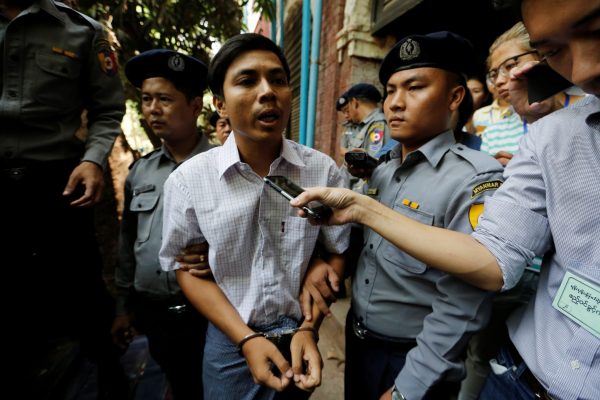Globally, there are growing concerns that trust in conventional media is decreasing as more people get their information from social media. This trend potentially undermines public willingness to stand up for press freedoms. Donald Trump’s charges of ‘fake news’ are being echoed by regional leaders, from Philippine President Rodrigo Duterte to Myanmar’s Aung San Suu Kyi. The cumulative effect is the undermining of journalism’s credibility.
Regional reports suggest that Southeast Asian publics generally do not trust the media they consume. This is dangerous when combined with the meteoric rise in reliance on social media for news by a Myanmar public largely uninformed about how to ‘read’ media critically. Myanmar-language media have been largely unsympathetic to the Rohingya, and social media have spread virulent hate speech. International media coverage has often been overly simplistic. Analysis regularly reduces a complex story into a Rohingya-as-victim narrative that, while largely true, leaves out historical and cultural context that would better inform public understanding of the crisis in Rakhine State.
Discussion of problematic coverage has become increasingly difficult as press freedom is threatened, seemingly no longer a goal of the National League for Democracy (NLD). The NLD has used various colonial- and military-era laws to silence dissent and prevent reporting on sensitive topics. Local and foreign journalists face increasing physical and legal dangers on the job. The number of journalists arrested and detained for defamation has substantially increased under the NLD. Some foreign journalists have left the country rather than put local reporters and fixers who help them at risk.
While these threats to press freedoms must be documented and resisted, a far less visible danger is the ongoing commercialisation and consolidation of media by crony owners who dominate the media landscape. The government’s continued control over both print and broadcasting infrastructure also presents significant barriers to entry for newcomers. Neither commercial nor state-run media are likely to prioritise investigative reporting or the concerns of minority groups, as this is rarely profitable. They are unlikely to raise issues currently off limits for public discussion.
Patterns ingrained during decades of information scarcity and control challenge the transition to more democratic forms of communication. These legacies are evident in the NLD’s attitude towards the press, its rhetoric charging international media with biased reporting and its restrictions on media access to Rakhine State. They are also evident in Myanmar media’s pro-Rakhine coverage.
The strongest buttress against the domination of media by the government and large private interests is the development of strong non-governmental, non-commercial public and community media sectors that prioritise diverse views and debate. Public media organisations worldwide are diverse but share some core principles: universal and free access for all citizens, independence, some form of public support, and regulations to ensure accountability and impartiality.
Now that the Myanmar people have tasted freedom of expression, they are unlikely to accept backsliding without a serious fight. Many civil society groups have already joined Myanmar’s journalists to fight for press freedoms. Important initiatives have emerged to challenge hate speech, promote media freedom and development media literacy. These include the Panzagar or ‘Flower Speech’ campaign of 2014, the Safe Online Space campaign of 2016 and Free Expression Myanmar. The Center for Youth and Social Harmony is an interfaith group actively promoting peace and fighting discrimination. And while the Facebook pages of some public officials mimic the formality of state-run media, others are far less formal. New forms of interaction are emerging in the comments sections of these pages, both between commenters and between commenters and public figures themselves.
Grassroots media initiatives have emerged around the country. The member organisations of Burma News International focus on local communities and encourage local people to create their own content. Such initiatives could eventually constitute a national network of community media — independent of state and commercial control — that feeds content and programming to a national public media system. This model is already emergent, as exemplified by the formerly exiled DVB Multimedia Group that early on established itself as an outlet for ethnic media content.
Myanmar’s policymakers should consider regulations to prevent further centralisation of media ownership and promote diverse viewpoints. One model for promoting diversity might be the Fairness Doctrine, enacted in the United States in 1949. The Doctrine required holders of licences to public US airwaves to air and include multiple perspectives in discussions of issues important to society. The Doctrine’s repeal in the late 1980s by then president Ronald Reagan significantly contributed to today’s polarised US media.
While the safety of Myanmar’s journalists and the protection of press freedoms remain vital, the democratisation of Myanmar’s media landscape will also require regulations to protect minority viewpoints and rigorous debate. Genuine public and community media offer vital alternatives to commercial and state-controlled media. They maintain the financial and editorial independence that enable them to challenge the state and mainstream opinion.
There is a key difference between public media, which are accountable to the public who pays for them, and media that serve the public — which do not directly engage the public but rather deliver messages from authorities. Unfortunately, this latter model seems to be the NLD’s current and future plan for public media in Myanmar.
Lisa Brooten is Associate Professor in Radio, Television and Digital Media at Southern Illinois University.

